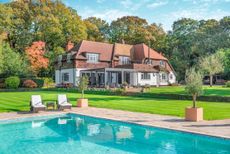House Historian blog: The Priory in Nottinghamshire
The former home of a Sheriff of Nottingham has come onto the market, and has a rich history of previous owners

The Priory in Mansfield Woodhouse, Grade II* listed and on the market with Chesterton Humberts, has seen a great number of changes over the last 500 years. However, despite its name and age, it has been discovered that it does not have any links to an early priory or an ecclesiastical building. It was in fact a Tudor cottage, a croft house and later a gentleman's residence, when it was the home of the Sheriff of Nottingham. Sadly, it is not the Sheriff of Robin Hood fame, but its location near Sherwood Forest does mean the house inevitably had links with royalty, being a favoured hunting ground for many generations.
The original house dates back to the 15th century, at the time Henry VIII came to the throne, when it would have appeared as a much simpler cottage. The house formerly belonged to the manor of Mansfield Woodhouse, which by the 17th century was in the hands of the Duke of Newcastle of the Cavendish family. The first Duke of Newcastle was a courtier of James I and later rose to become tutor to Charles II.
By the 18th century, the manor had passed to the Dukes of Portland and by the 1760s was in the hands of Dowager Duchess of Portland, the richest woman in Great Britain. While the manor was in the hands of grand landowners, the house (not yet known as ‘The Priory') had been altered and renovated, but very little is known about the early occupants.
By 1785, the house was purchased by another prominent landowner, John Coke, whose father was D'Ewes Coke, colliery owner, philanthropist and the rector of Pinxton. When John Coke purchased the house, he was living in Debdale Hall, now Thistle Hill Hall, and was involved with a number of projects in the area, including the Pinxton Railway, Pinxton Colliery and the Pinxton porcelain factory. It was John Coke who became high-sheriff of Nottingham in 1830, as well as magistrate and later deputy-lieutenant for Nottinghamshire.
After John Coke passed away in 1841, ownership of the house passed to his nephew, Edward Thomas Coke, Esq. At this time the house was still a large croft house, but Edward undertook the rebuilding of the house, including adding the stone frontage and it was Edward who was responsible for naming the house ‘The Priory'.
Records show that the house became the home of George and Sarah Sophia Robinson. George was an officer in the Royal Navy and often away from home, while Sarah was the granddaughter of D'Ewes Coke, and thought to have been the sister of Edward Coke. At the time of the 1851 census, Sarah was in the house with her five children, aged between 22 and 2 years old, while George Robinson was away at sea.
By the late 1870s and early 1880s, the Robinson family moved away from The Priory and the house becomes the home of bank manager of Mansfield, William Abraham Hodges. The 1891 census shows William in the house (while his wife was away from home) with his five children and four live-in servants.
Sign up for the Country Life Newsletter
Exquisite houses, the beauty of Nature, and how to get the most from your life, straight to your inbox.
By the turn of the 20th century, The Priory was owned by Major General John Talbot Coke, but in 1907 the house was put on the market. The sales particulars described the house as ‘commodious freehold mansion house' and ‘the house is sunny and in good repair'. The house was purchased by Mr. F. P. Cook, but was occupied by Dr. Reginald Anthony Eastmond and his wife Jennie.
The 1911 census reveals that it was at this time that the Priory was divided into two separate homes, known as The Priory and Western Priory, with one half occupied by Dr. Reginald and Jennie Eastmond, a doctor's assistant Charles Clive and two live-in servants. Dr. Eastmond later went on to enlist in the Royal Army Medical Corp in 1915 and was promoted to Captain in 1916. The other part of the house was home to mining engineer, Raymond Nadin and his wife, Winifred and their one year old daughter, Patricia.
Throughout the 20th century the house continued as two separate homes and it was only during the 1980s that it once again became a single family home.
More details on The Priory
To read the full history of the house visit my blog - The House Historian
Country Life is unlike any other magazine: the only glossy weekly on the newsstand and the only magazine that has been guest-edited by HRH The King not once, but twice. It is a celebration of modern rural life and all its diverse joys and pleasures — that was first published in Queen Victoria's Diamond Jubilee year. Our eclectic mixture of witty and informative content — from the most up-to-date property news and commentary and a coveted glimpse inside some of the UK's best houses and gardens, to gardening, the arts and interior design, written by experts in their field — still cannot be found in print or online, anywhere else.
-
 A well-connected rural playground with 23 acres on the edge of the South Downs National Park
A well-connected rural playground with 23 acres on the edge of the South Downs National ParkOld House Farm is an impressive family home with a wealth of amenities that would inspire any rural passion.
By Arabella Youens Published
-
 The UK gets its first ‘European stork village’ — and it's in West Sussex
The UK gets its first ‘European stork village’ — and it's in West SussexAlthough the mortality rate among white storks can be up to 90%, the future looks rosy for breeding pairs in southern England.
By Rosie Paterson Published
